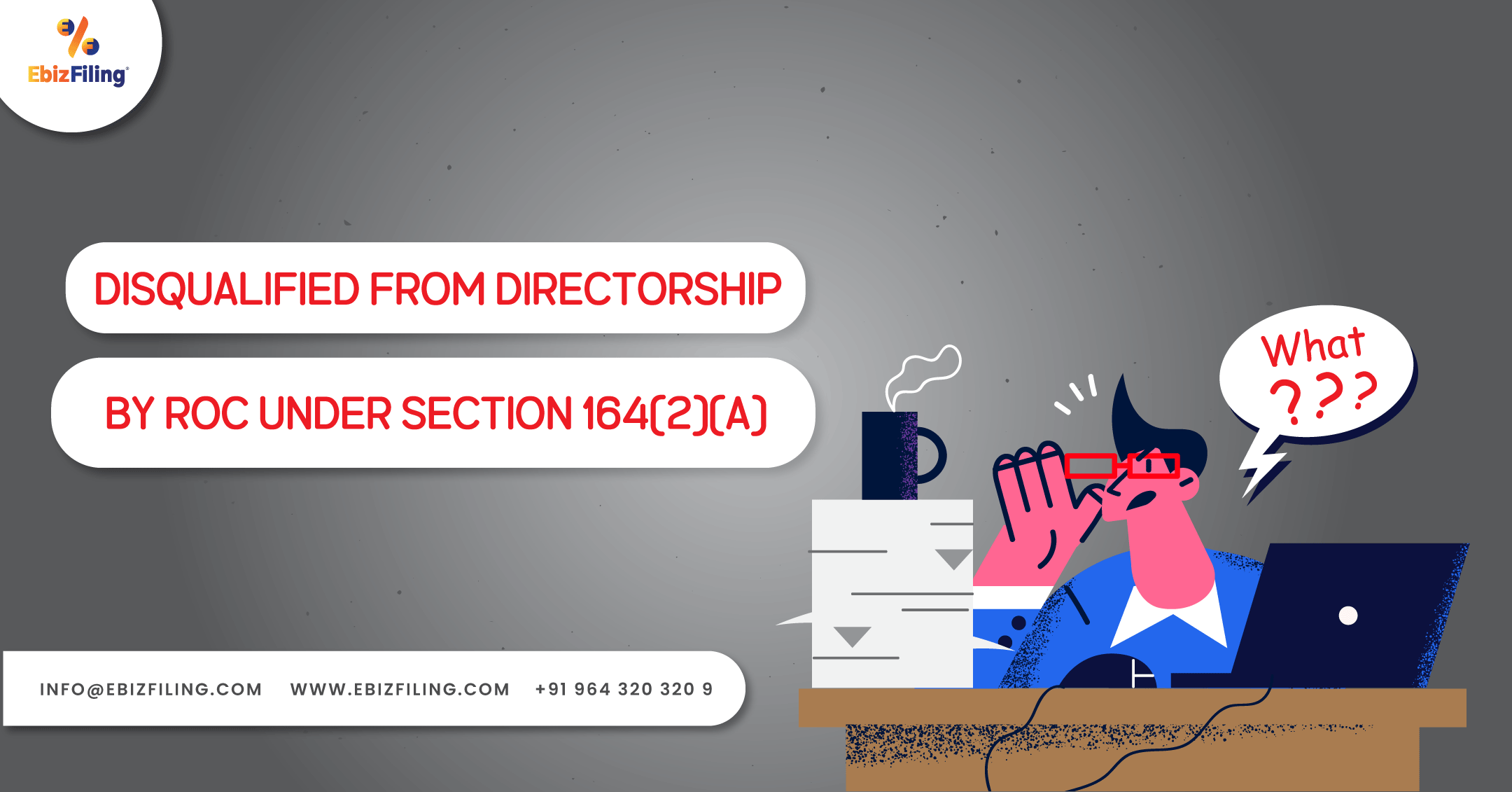
-
July 17, 2024
Disqualification of Directors Under Section 164(2)
The Director Identification Number (DIN) is a unique number assigned by the Central Government to individuals who aspire to become or are already serving as directors of a corporation. A DIN is mandatory for all company directors. Section 164(2) of the Companies Act, 2013 empowers the Registrar of Companies (ROCs) to disqualify directors by rejecting their DIN. This article focuses on disqualified directors under Section 164(2).
Introduction
When a director is disqualified by the ROC (Registrar of Companies), they are prohibited from serving as a director of any company for the duration of the disqualification. The Act’s Section 164(2) has a broad scope regarding the disqualification of directors. If a corporation where a director holds directorship commits a default, it subjects the director to disqualification.
Let’s have a look at “What is Section 164(2), before understanding about the Disqualification of Directors u/s 164(2).
What is Section 164(2)?
According to Section 164(2), a director is ineligible to be re-appointed as a director of a business or to be appointed as a director of another company for five years after the company of the director fails to comply with the following:
-
For three consecutive financial years, has not filed annual returns or financial statements
-
Has failed to return any deposits it has accepted, pay interest on deposits, redeem debentures on the due date, pay the interest due on debentures, or pay any dividend declared for a period of one year or longer.
What is Disqualification of Director as per Section 164 (2)?
Under section 164(2)(a) of the Companies Act, 2013, a company’s failure to file financial statements or annual returns for three consecutive years empowers the Registrar of Companies (ROC) to disqualify its directors. This disqualification of directors involves deactivating their Director Identification Number (DIN), rendering them ineligible for appointment or reappointment as directors for a five-year period.
In 2017, the DINs of all directors marked as inactive by the ROCs due to company director disqualification under Section 164(2) were prohibited from serving as directors in any other company for five years. After the MCA de-flags the company director disqualification of a DIN, a director who has been disqualified under Section 164(2) of the Act is eligible to be re-appointed as a director of a business. The MCA will de-flag the disqualified DIN (Director Identification Number) five years from the date of the company director disqualification.
Reasons for Disqualification of Directors
-
When a company fails to pay interest on deposits or reimburse a deposit it has received.
-
If the organisation fails to pay the required interest or redeem the debentures by the due date.
-
Failure to pay the declared dividend and continuing to do so for more than one year may result in the company’s director being disqualified.
-
If the director has applied for insolvency adjudication.
-
If the director has been previously disqualified by a court.
-
If the board of directors fails to disclose their or joint ownership interests in any corporation.
-
If the director has been convicted of a crime and sentenced to more than 6 months in prison by a court.
-
If a court determines that the director is mentally ill.
-
If the company’s director is found guilty under section 188 of the Criminal Code for party transactions made by the director in the previous five years.
-
Directors who are still insolvent can be disqualified by the court.
Consequences of Disqualification of Directors
If someone is disqualified, they cannot become a Director of that company or any other company. This restriction lasts for five years or as required. Since 2017, the Ministry of Corporate Affairs (MCA) has been strictly enforcing these rules of the Companies Act. Recently, the MCA has published the names of the disqualified Directors on the government website.
Information on appealing Disqualified Directors
An order disqualifying a Director does not take effect within 30 days of a conviction resulting in a sentence or order, according to the Companies Act 2013. As a result, anyone who has received an order has 30 days to file returns and appeals in order to stop the proceedings.
Once an appeal is filed, the person will continue to serve as Director for another seven days after the appeal or petition is dismissed. As a result, anyone who has been disqualified as a Director must file an appeal as soon as possible, along with any overdue returns, in order to have a strong chance of continuing to act as a Director.
Important solution for Disqualification of Directors u/s 164(2)
The Companies Act of 2013 does not include provisions for removing DIN disqualifications. If disqualified, a director can appeal to the National Company Law Appellate Tribunal (NCLAT) and seek a temporary stay order. The disqualification order against a director does not become effective until 30 days after it is issued under the Act.
When a director appeals to the NCLAT, they remain in their position at the defaulting firm for seven days. Directors must file annual returns within seven years to avoid disqualification. There’s no process to reappoint a disqualified director. However, after five years of disqualification, a director can be reappointed.
Directors can appeal to the High Courts to lift their disqualification. However, different High Courts have varying views on whether disqualification under Section 164(2) should be removed. For instance, the High Courts of Gujarat, Karnataka, Madras, and Allahabad have provided specific directives and removed ineligible directors from the ROC lists. In contrast, the Mumbai High Court does not typically lift director disqualifications.
Conclusion
Several company directors moved the High Court/National Company Law Tribunal (“NCLT”) to have their DINs and companies revived under Article 226 of the Indian Constitution and Section 252 of the Companies Act, 2013.
The company must file an application to resuscitate itself in respect to the disqualification of directors under section 252(3) of the Companies Act. This application can also be submitted by a member, creditor, or even a worker. However, disqualified directors are not eligible for re-appointment in the same or any other corporation unless they correct their error.
Removal or Resignation of Director
Conduct an easy removal/resignation procedure of a director from Company.
About Ebizfiling -










Reviews
Ashrith Akkana
19 Apr 2022I took import export certificate from the ebizfiling. They have done the work on time.. Thank you for making my import export certificate in time 😊
Jayesh Tejani
28 Aug 2017It is a very professional set up and a really dedicated team. You guys did a great job for my Trademark application in a really short time. All the best to you and your team.
Ritwik Kapur
04 Apr 2022Finally, we can concentrate on our business & let consultants take care about compliances. Tried ebizfiling after being very unsatisfied with my previous CS. Really impressed with their process, their commitment to deadline & followups. I was a little late in filing Form-8 for my LLP this year, thanks to my previous consultant & wanted to change my compliance manager. Ebiz did a fabulous job in minimising the penalty & filing on time. Cheers to Aishwarya & Nilesh for their teamwork and knowledge. I had dropped mails to other firms too to hire them but these guys' awareness about the compliance law drove me towards Ebiz. Affordable fee is a big Plus. Will be using them for all compliance related services.
February 27, 2025 By Team Ebizfiling
Legal Implications of Articles of Association (AOA) under company Law In Company Law, the AOA (Articles of Association) outlines a company’s internal rules, regulations, and governance structure. It defines how the company manages its operations, specifying the rights and responsibilities […]
February 12, 2025 By Team Ebizfiling
Difference Between Executive and Non-Executive Director Introduction Directors are pivotal to the success and governance of any organization. Among them, the roles of executive and non-executive directors stand out as distinct, both in responsibilities and contributions. Understanding the difference between […]
May 24, 2025 By Team Ebizfiling
What Are the taxation rules for LLC? Taxation rules for LLC for a Limited Liability Company (LLC) in the United States involves understanding its distinct structure and applicable regulations. LLCs provide flexible tax options and reduced personal liability, making compliance […]